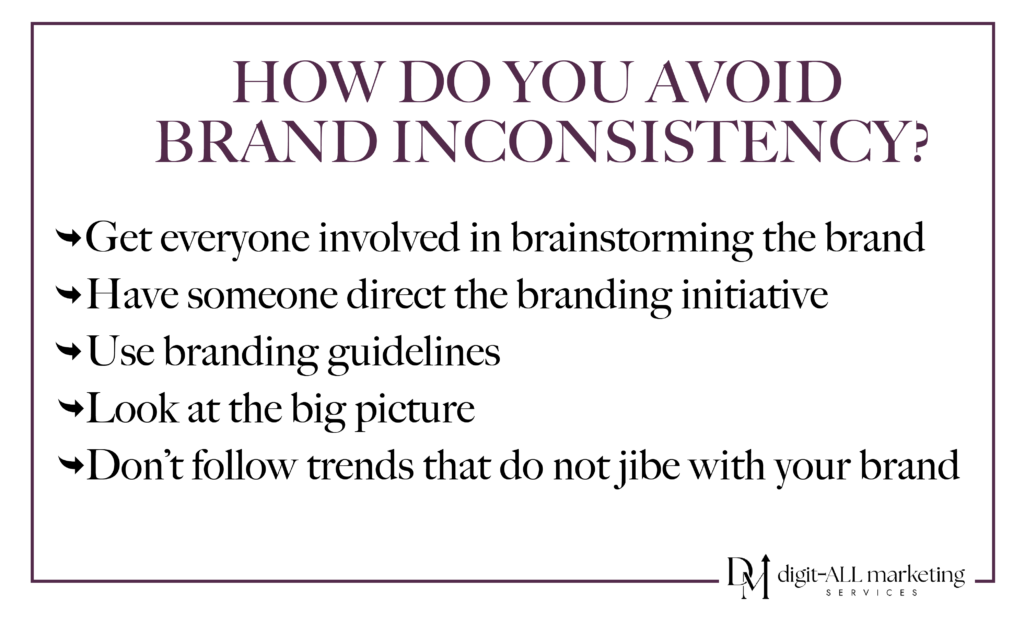THIS IS digit-ALL’s THIRD ARTICLE IN A FIVE-PART SERIES ABOUT COMPANY BRANDING AND BRAND CONSISTENCY.
Branding, in an overly simplistic nutshell, creates trust, while inconsistent branding does not. It’s your way to associate your products or services with your values and your promise to the customer. Customers want to invest in brands that keep their word by standing for what the brand is promising. The brand is why people buy the product or service. It’s why people buy Coke over Pepsi. Ben and Jerry’s over Breyers. Nikes over Adidas.
(Need to know more about branding in general? Start with our first part of the series: What Is Branding, and Why Does It Matter?)
Inconsistent branding, on the other hand, creates confusion and distrust. Why? Customers have expectations, and they expect a certain product or service at a certain level of quality/convenience. If Walmart started offering Tiffany’s rings in its jewelry section, you would be confused and distrustful–is Walmart now raising its prices and is Tiffany’s now lowering its standards?
This product offering would be inconsistent for both company brands, it would show a divergence in each company’s purpose behind why they serve the customers they do, and distrust for both companies would start to grow.
This would be brand inconsistency, and it can poison your company.
What Are Examples of Inconsistent Branding?
Inconsistency with your brand can come in many forms and lead to multiple issues:
- Inconsistent imagery leads to confusion: If you are a tea company trying to get more Gen Z’ers to drink your coffee, does it make sense to show an image of seniors drinking it in an assisted living facility? What if your tea is supposed to be calming–would bright red backgrounds make sense?
- Inconsistent timing leads to forgetting: You need to post on social media and your blog in a consistent manner as part of a consistent brand. This doesn’t mean daily, but you also shouldn’t drop off the face of the earth for a month. In terms of your email marketing, definitely don’t send an email every few months. There are a lot of companies vying for attention in the digital world, and going radio silent will not help your brand.
- Inconsistent tone leads to annoyance: If your company is professional on its website, funny on Facebook, and a hodgepodge of information in your emails, you are going to turn off your customers. Why? They depend on your company to act like a credible business. Inconsistent tone makes a company come across as flakey, and worse, may lead to customers thinking you won’t be a good investment for their money.
Why Does Brand Inconsistency Happen?
Inconsistent branding happens because:
- There is fear in wholeheartedly committing yourself to creating a brand that’s tied to your company’s values and purpose. It’s complicated, and possibly overwhelming! But you’ve got to make a decision in order to even have a brand. A quick tip: start with your why, as Simon Sinek would say. (For more on values and purpose, What You Need Before Starting Your Company Branding.)
- There is a lack of ownership. A company that doesn’t task anyone with overseeing the company’s branding will remain a company that will always have a weak or non-existent brand.
- There is a misunderstanding about branding being just about a logo and a company name. Imagine if Coke had done that! Or if Ben and Jerry’s had done that!!
- The brand doesn’t know how to deliver on the product or service’s unique selling proposition (USP) and relies on trying to sell everything to everyone. (For more on USP, go and visit our blog post, What You Need Before Starting Your Company Branding.)
You break your brand contract with your customers/potential customers. For instance, if you promise great customer service, you must follow through with that as part of your brand promise. In all aspects of your brand, across all areas you have a presence (e.g., your website, social media, in your store, in an email).

How Do You Avoid Inconsistent Branding?
Yes, you can avoid brand inconsistency. You can:
- Have everyone involved in brainstorming the brand. The CEO sees one side of the business and the intern sees another side. It’s important not to be in an echo chamber when solidifying branding.
- Have someone direct the branding initiative. Branding shouldn’t be an abstract thought that “We should do.” It needs to be guided by someone or someones.
- Have branding guidelines. This is where the company’s mission statement, values, purpose, colors, fonts, tone, social media outlets, etc. hang out for easy reference. (More about this will be discussed in our upcoming blog post: What to Include in Your Brand Guidelines.) This gives the company a roadmap for the brand that includes the past, present, and future of the brand.
- Look at the big picture: how does the company want to be perceived and how do customers actually perceive them? Customer feedback is invaluable for this exercise!
- Don’t follow trends that do not jibe with your brand. Social media is full of trends as everyone competes for views and likes and followers. But if that trend does not fit your brand/values/purpose/why, let it slip away.
How Can You Establish a Consistent Brand?
Yes, there are steps you can take to create a consistent, strong brand that helps customers have the correct perception of you:
- Know your mission statement, purpose, and values. We talk more about that in our blog post, What You Need Before Starting Your Company Branding.
- Know your messaging, and how you plan to reflect not only WHY you’re in business but also the personality of that business. Think of the light humor of Netflix or Wendy’s on Twitter compared to…other things on Twitter.
- Allow for your customers’ perception to help you tweak your brand. Do they love your on-time service but you’re pushing your quality parts? Maybe start focusing more on the time element.
- Seek out the perception of multiple generations, genders, and cultures. This will help you prevent fatal missteps before they can happen.
- Carry the same branding message throughout your company–from how a phone is answered to how the company’s homepage looks to the latest company post on Instagram.
The Take-Home Point
One of two things will happen when a company has inconsistent branding. One, companies underestimate the power of creating a strong brand and never stand out from the competition. Two, companies neglect maintaining the brand based on the intersection of company values and customer perception–creating a brand that speaks to no one.
Don’t let this happen to you. By creating brand consistency, customers will understand what to expect from your company. When customer expectations are being met, loyalty and trust and sales grow.
NEXT UP IN OUR COMPANY BRANDING SERIES: How to Develop Brand Guidelines
OTHER ARTICLES IN THIS SERIES:
- What Is Branding, and Why Does It Matter?
- What You Need Before Starting Your Company Branding
- Quiz Yourself: Good Branding or Bad Branding?
digit-ALL is a full-service marketing company that focuses on the people side of marketing. We focus on websites and company branding, social media, blogs, newsletters, and even corporate event planning. We’re here to help when you’re ready for it.
SOURCES
“The Negative Impact of Inconsistent Branding,” Shell Robshaw-Bryan, SocialMediaToday.com.
“16 Mistakes That Make Brands Seem Inconsistent To Audiences,” Forbes.com.
“Avoiding an Identity Crisis: The Dangers of Inconsistent Branding,” Steve Harvey, Medium.com.
“3 Embarrassing Branding Mistakes,” NewsletterPro.com.
“Inconsistency Is a Content Marketing Poison, But It Doesn’t Have to Be,” Timothy Carter, Entrepreneur.com.
“Bad Branding: How to Avoid the Worst Branding Mistakes,” Peter North, 99Designs.com.
“The Twenty Most Common Brand Problems,” Brad VanAuken, BrandStrategyInsider.com.





